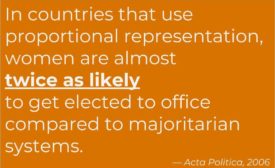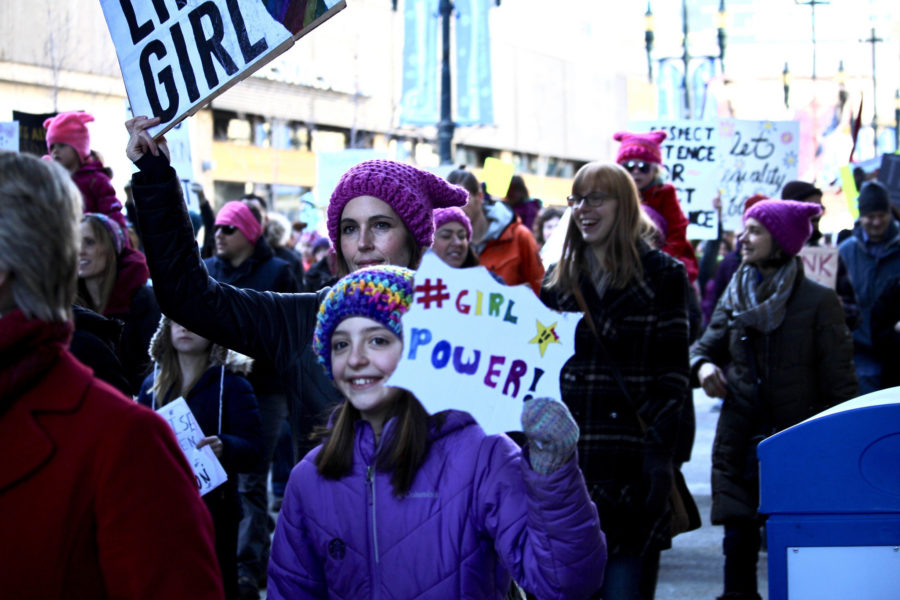New Zealand’s prime minister, Jacinda Ardern, appeared on The Late Show with Stephen Colbert the other night. Ardern is notable in many ways. As Colbert pointed out, she’s the second-youngest leader of New Zealand—at 37, she’s also the youngest elected woman leader in the world today. She’s one of the world’s 10 women heads of state (that’s just over 7 percent of 137 chiefs of government worldwide). She’s New Zealand’s third woman prime minister in around 100 years. And she’s the second head of state in history to give birth while in office—ever. (Hence, alas, an inordinate amount of press focus on her multitasking while breastfeeding).

Ardern is also notable because she’s in office in large part due to New Zealand’s electoral system. New Zealand uses proportional representation to elect its leaders.
Proportional Representation Systems Elect More Women
Proportional Representation, or ProRep, is a system in which parties gain seats in the legislature in proportion to their share of the vote.
Ardern’s party won enough seats to sway other parties to form a coalition government. Lots of other factors were in play, of course, but New Zealand’s electoral system gives women better odds to get elected and secure leadership positions. It didn’t always. In the 1990s the country switched from first-past-the-post (FPTP) elections to a proportional system. As Kristin Eberhard has documented, New Zealand is an instructive case study for electoral reform in the US and Canada, where we still use New Zealand’s old system. In fact, voters in British Columbia are voting between now and November 30 to decide whether to upgrade their electoral system. The share of women elected to New Zealand’s parliament jumped from around 16 percent to a solid 30 percent after switching to a proportional system. Women have also expanded their role on New Zealand’s leadership cabinet, going from zero under FPTP to seven to nine of 27 members with proportional representation.
Move the slider below to see New Zealand’s parliament before and after it switched to ProRep.
And it’s not just New Zealand. Around the world, there’s ample evidence that proportional countries elect more women. In countries that use proportional representation, women are almost twice as likely to get elected to office compared to winner-take-all systems. In a comparative study of 36 countries, the share of women elected to the legislature was 8 percentage points higher in proportional representation countries. All the ProRep countries in Western Europe have at least 20 percent women in parliament. In particular, party-list systems with large districts appear to boost women’s representation the most. But overall, in study after study (and correcting for other cultural variables), women fare better in proportional systems than in winner-take-all ones.
New Zealand and Germany are also particularly instructive in that both countries elect some legislators with proportional representation and some in FPTP (also called winner-take-all) districts. In one example, the two countries’ winner-take-all districts elected 15 percent and 13 percent women respectively, while the proportional districts elected 45 and 39 percent.
Women in Office Make a Difference

There is a growing body of literature suggesting that issues of particular concern and importance to women are more likely to be addressed and elevated when more women hold elected office. Research indicates more women in office tends to lead to more successful “women-friendly” policy agendas, notably in areas like pay equity, parental leave, and daycare. Research has shown that female state legislators in the US and in democracies across the globe tend to have more innovative and expansive family policies, and pass more laws that benefit women, children, and families.
Studies of US state legislatures also found that female members are more likely than men to see themselves as representatives of women. There’s also evidence that women legislators in both advanced, industrialized countries and less developed countries place higher legislative priority on women’s rights than do men.
Research shows that, on average, women legislators sponsor more bills, pass more laws, and send their districts more money than their male counterparts.
As voting-system expert Douglas Amy and others point out, policy impacts of more a balanced share of women in office would likely extend beyond the realm of conventionally-defined “women’s issues.” Women’s political positions are not monolithic, and women adhere to party platforms just like any other office holder. But polling consistently shows that American women, for one example, are more likely than their male counterparts to support stricter gun control and climate action. As voters, women in the US are more likely to prioritize poverty and homelessness prevention.
In the US Congress, research shows that, on average, women legislators sponsor more bills, pass more laws, and send their districts more money than their male counterparts.
Women Are More Politically Engaged in ProRep Countries
ProRep countries enjoy higher voter turnout overall, but especially among women—perhaps because more women seek and win office. Some scholars suggest that the share of female representatives accelerates faster under ProRep because women officeholders serve as role models, which encourages other women. A copycat phenomenon may also influence progress among parties: smaller or more left-leaning parties might advance women candidates first, and bigger or more middle-of-the-road parties working to appeal to women voters follow their lead. One study found that where there are more women in parliament, adolescent girls are more likely to discuss politics with friends and to intend to participate in politics as adults.
Winner-take-all, Single-Winner Districts Are a Barrier to Gender Equity
Winner-take-all systems with single-winner districts (like we use most places in the US and Canada) come out looking suboptimal for women.
In single-winner systems there are fewer incentives to support women and minority candidates; parties and voters are more likely to seek out candidates viewed as “most broadly acceptable” or “safe and mainstream,” which privileges men. In campaigns and in office, women can be simultaneously punished both for being too “feminine” and for conforming to masculine norms.
Winner-take-all electoral systems seem to induce more competitive, confrontational, exclusionary politics that privilege “masculine” traits, while women’s conventional gender norms find a better fit in proportional systems which tend to favor bargaining and compromise and to produce more inclusive, consensual governments.
Around the world, the countries with fewer than 10 percent female representation are far more likely to have a winner-take-all system than a proportional one. Nearly 90 percent of countries that have no female legislators use a winner-take-all system. The US and Canada rank number 103 and number 60 in the world in terms of women in the legislature, respectively. In Rwanda, Nicaragua, Mexico, South Africa, Namibia and many other countries with proportional systems women comprise about 42 percent of legislators, compared to 19 percent in the US, and 26 percent in Canada.
And places that switched from multi-winner to single-winner districts saw women’s representation decline.
True Democracy Requires a Balance of Men and Women
Ultimately, a democratic system’s legitimacy is on the line when women are left out. Is it really a democratic system if certain viewpoints or groups are excluded from decision-making? On the flip side, in the United States, the inclusion of women in elected office sends signals to both male and female citizens that politics is open to all. When policies of particular concern for women are mostly decided by male legislators, it erodes perceptions of legitimacy. In a study of 31 democracies, male and female respondents believe that government is more democratic when more women hold office.
A proportional voting system isn’t the only factor in women’s equity gains, but it creates better conditions—or an important facilitating mechanism—for women’s political success. The #MeToo moment is giving women a more powerful voice. But worldwide, women still only represent a scant 20 percent of all federal-level legislative seat holders (despite being roughly half the population, everywhere). As UK journalist Eve Livingston declared in 2017, it’s worth considering “electoral reform as a feminist issue.”
Maithili Joshi contributed research for this article.


Comments are closed.